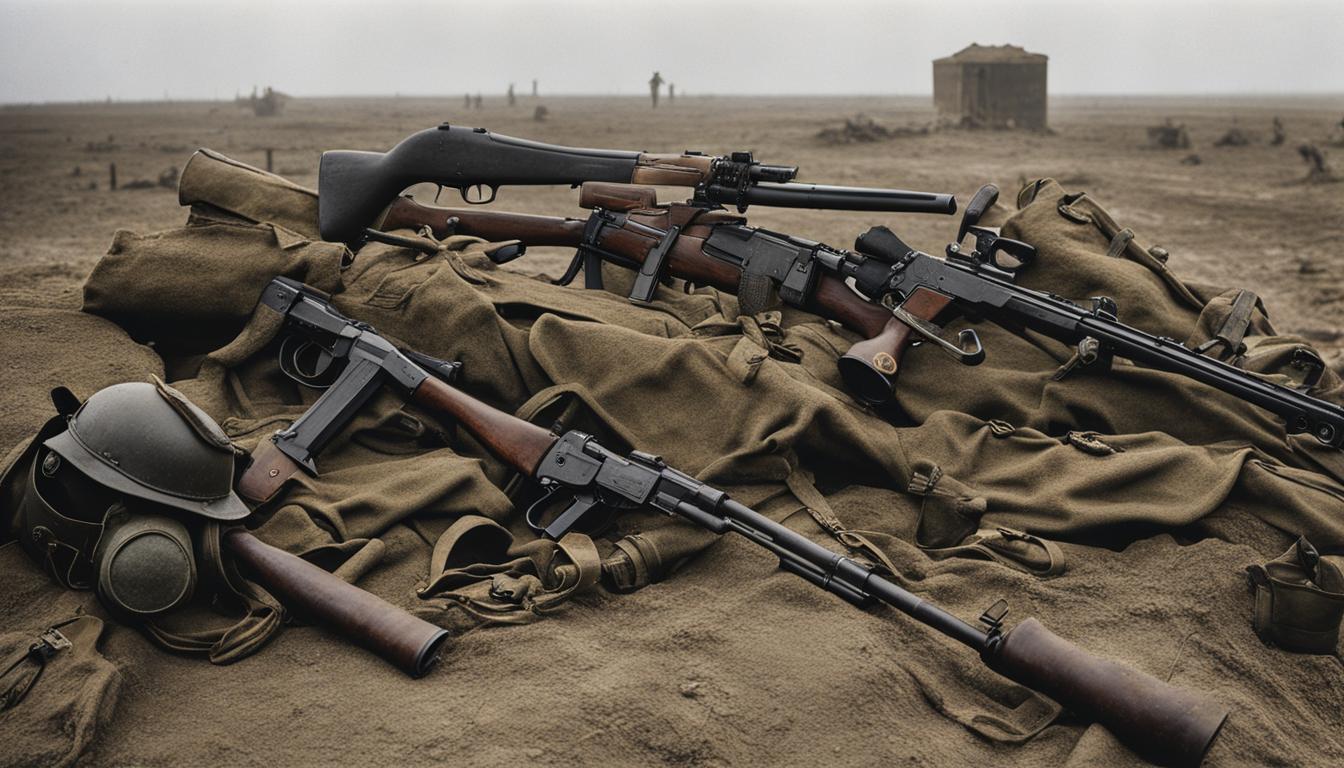The First World War, also known as WW1 or World War 1, was a conflict characterized by the devastating firepower of modern weaponry. The British Army, like other armies, had to adapt their tactics and develop new technologies to break the trench stalemate on the Western Front. In this detailed guide, we will explore the various weapons used by the British Army during WW1, including firearms, artillery, tanks, poison gas, trench warfare weapons, and machine guns.
Key Takeaways:
- WW1 introduced a range of devastating weapons that forever changed the face of warfare.
- Artillery played a crucial role in destroying enemy positions and supporting troop advancements.
- Machine guns were deadly weapons that caused massive casualties in trench warfare.
- Aircraft emerged as a new form of warfare, conducting aerial combat and bombing raids.
- Tanks revolutionized battlefield mobility, allowing troops to break through enemy lines.
Artillery: Destructive Power on the Western Front
Artillery played a devastating role in World War 1, particularly on the Western Front. The sheer firepower and destructive capabilities of artillery made it a key weapon in the conflict. The British Army, like other armies, relied heavily on artillery to destroy enemy positions, break through fortified defenses, and support infantry advancements.
During World War 1, artillery was used in various ways. Initially, the British bombarded the enemy before sending infantry over the top. However, as the war progressed, this tactic became less effective due to improved enemy defenses and the development of new strategies. The British then started using artillery defensively, unleashing barrages to suppress enemy fire and support the advancement of their own troops. Tactics such as the creeping barrage, where artillery fire moved slowly forward to clear paths for infantry, were developed and employed.
To locate and neutralize enemy artillery, the British utilized new technologies such as aircraft, sound ranging, and flash spotting. Aircraft were used for artillery spotting, providing valuable intelligence on enemy positions. Sound ranging involved using microphones to track the sound of enemy artillery fire and determine its location. Flash spotting, on the other hand, relied on observing the flash of enemy artillery fire to pinpoint its position. These methods enabled the British to effectively counter enemy artillery and minimize the impact on their own troops.
| Artillery Tactics in World War 1 | Advantages | Disadvantages |
|---|---|---|
| Bombardment | – Could weaken enemy defenses – Provided cover for infantry advances |
– Less effective against fortified positions – Alerted the enemy to an upcoming attack |
| Creeping Barrage | – Cleared paths for infantry – Suppressed enemy fire |
– Required precise timing and coordination – Risk of friendly fire |
| Defensive Barrage | – Suppressed enemy fire – Provided cover for counterattacks |
– Less effective against mobile enemy forces – Risk of friendly fire |
The destructive power of artillery on the Western Front cannot be overstated. It brought immense devastation and loss of life to both sides of the conflict. Its effectiveness, however, waned over time as new defensive strategies were developed and armies adapted to counter artillery barrages. Nevertheless, artillery remained a crucial component of World War 1 warfare, shaping tactics and strategies that would influence future conflicts.
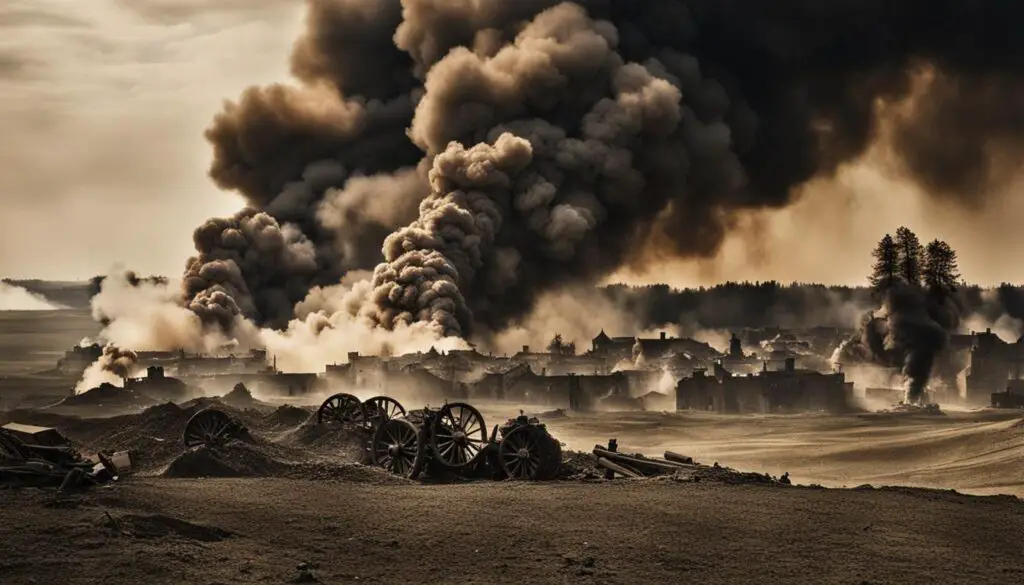
Machine Guns: Deadly Killing Machines
During World War 1, machine guns played a vital role in the British Army’s arsenal, providing deadly firepower and shaping the course of trench warfare. The Vickers machine gun was a key weapon used by the British forces, known for its reliability, high rate of fire, and long-range capabilities. Operated by a team of two gunners, the Vickers machine gun was employed for mobile support and aircraft mounting, effectively mowing down enemy troops and providing cover for advancing soldiers.
Another notable machine gun used by the British Army was the Lewis Gun. This lightweight and portable weapon was widely utilized in ground combat, providing effective firepower and supporting infantry movements. The Lewis Gun contributed to the British Army’s ability to suppress enemy positions and gain tactical advantages on the battlefield.
Machine guns played a significant role in trench warfare, where their devastating firepower caused immense casualties and forced soldiers to seek cover. The rapid and sustained fire of machine guns made it difficult for opposing forces to advance, contributing to the stalemate on the Western Front. These deadly killing machines forever changed the nature of warfare, highlighting the importance of firepower and the need for innovative tactics to counter their devastating effects.
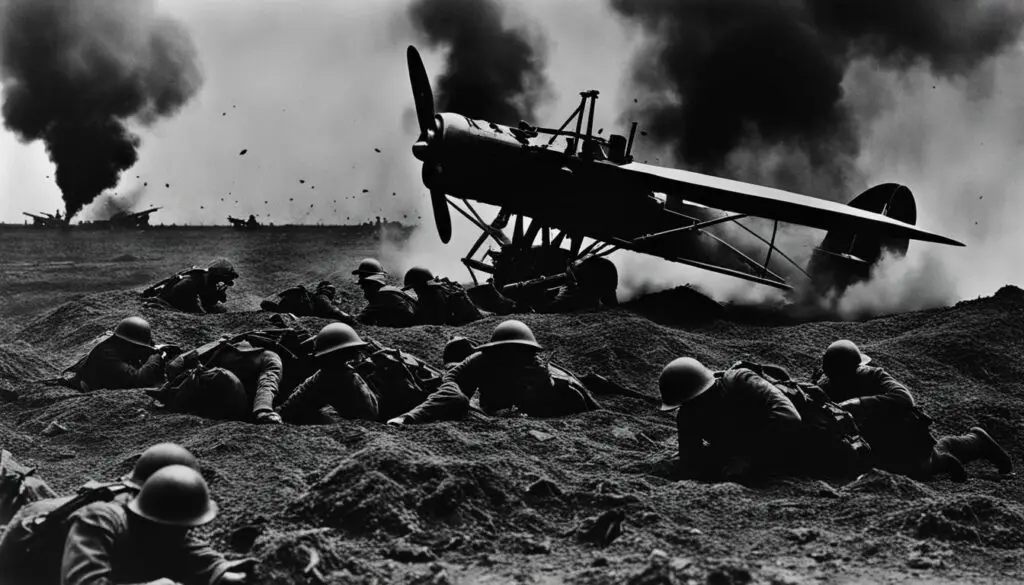
Table: Comparison of Vickers and Lewis Machine Guns
| Machine Gun | Key Features | Usage |
|---|---|---|
| Vickers Machine Gun | Reliable, high rate of fire, long-range | Mobile support, aircraft mounting |
| Lewis Gun | Lightweight, portable | Ground combat |
Aircraft: The Rise of Aerial Warfare
The use of aircraft during World War 1 marked a significant shift in military strategy and tactics. Initially, aircraft were primarily used for artillery spotting and reconnaissance, providing valuable information about enemy positions and movements. However, as the war progressed, fighter planes equipped with machine guns took to the skies, engaging in aerial battles that would shape the future of warfare.
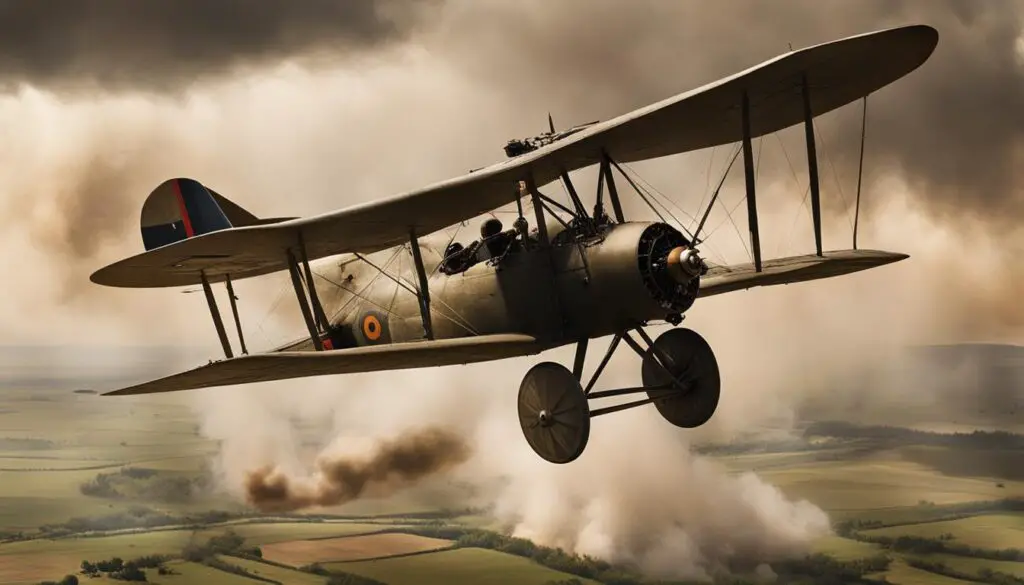
Bombing raids became another crucial aspect of aerial warfare during WW1. Aircraft were used to drop bombs on enemy trenches, troop concentrations, and industrial facilities, causing widespread destruction and disruption. This new form of warfare not only posed a threat to ground troops but also influenced the development of aircraft technology.
Advancements in aircraft technology during WW1 paved the way for future innovations in aviation. Faster speeds, better weaponry, and the introduction of dive bombing tactics were all influenced by the experiences and lessons learned from aerial combat in WW1. The impact of these technological advancements can still be seen in modern warfare.
Aerial Battles and Fighter Planes
Aerial battles in WW1 were intense and played a crucial role in gaining air superiority. Fighter planes were specifically designed for air-to-air combat, armed with machine guns to engage enemy aircraft. These battles often involved daring dogfights and maneuvers as pilots fought for control of the skies.
Quotes:
“The rise of aerial warfare in WW1 ushered in a new era of combat, with fighter planes engaging in fierce battles for control of the skies.”
“WW1 marked the birth of aerial combat, as fighter planes armed with machine guns took to the skies to engage in deadly dogfights.”
Bombing Raids and Strategic Impact
Bombing raids conducted by aircraft in WW1 had a significant strategic impact on the battlefield. The ability to drop bombs from the air provided a new dimension to warfare, allowing for targeted attacks on key enemy positions. Bombing raids disrupted enemy trenches, destroyed vital infrastructure, and demoralized opposing forces.
Lists:
- Aircraft bombing raids targeted enemy trenches, troop concentrations, and industrial facilities.
- The destruction caused by bombing raids disrupted enemy defenses and demoralized opposing forces.
- Strategic bombing played a crucial role in gaining an advantage on the battlefield.
Technological Advancements
The development of aircraft technology in WW1 set the stage for future advancements in aviation. Faster aircraft speeds allowed for quicker reconnaissance and improved tactical capabilities. Better weaponry, such as synchronized machine guns for firing through the propeller arc, gave pilots a significant advantage in aerial combat. The introduction of dive bombing tactics allowed for precision strikes on ground targets.
Table:
| Aircraft Technology Developments in WW1 | Effects on Modern Warfare |
|---|---|
| Faster speeds | Increased reconnaissance capabilities |
| Synchronized machine guns | Improved air-to-air combat capabilities |
| Dive bombing tactics | Precision strikes on ground targets |
The rise of aerial warfare in WW1 had a profound impact on military strategy, tactics, and technology. The use of aircraft for reconnaissance, aerial combat, and bombing raids revolutionized the way wars were fought. These developments in aircraft technology during WW1 laid the foundation for future advancements in aviation and continue to shape modern warfare.
Tanks: A Game-Changer on the Battlefield
The introduction of tanks during World War 1 revolutionized the battlefield, providing a new level of mobility and firepower. The most notable tank used by the British Army was the British Mark I tank. This armored vehicle had a top speed of 3mph and featured an innovative design that allowed it to traverse trenches.
Tanks played a crucial role in breaking the stalemate of trench warfare. They were used to spearhead offensives, providing cover and support to infantry troops. With their thick armor and mounted guns, tanks were able to withstand enemy fire and clear the way for advancing forces.
To showcase the capabilities of tanks in the field, a table could be created to compare the British Mark I tank to other armored vehicles used during World War 1. This would provide a visual representation of the advancements made in tank warfare during this time. The table could include data on speed, armor thickness, weaponry, and trench-crossing capabilities.
| Armored Vehicle | Speed | Armor Thickness | Weaponry | Trench-Crossing Capabilities |
|---|---|---|---|---|
| British Mark I Tank | 3mph | Up to 12mm | Several machine guns and cannons | Capable of crossing trenches up to 2 meters wide |
| German A7V Tank | Up to 5mph | Up to 30mm | Machine guns and cannons | Capable of crossing trenches up to 1.8 meters wide |
| French Renault FT-17 | Up to 5mph | Up to 22mm | Machine guns and cannons | Capable of crossing trenches up to 1.7 meters wide |
The development and use of tanks during World War 1 had a lasting impact on modern warfare. The lessons learned from early tank warfare led to the continued advancement and refinement of tanks in subsequent conflicts. Today, tanks are an essential component of military forces around the world, providing armored support and strategic capabilities on the battlefield.
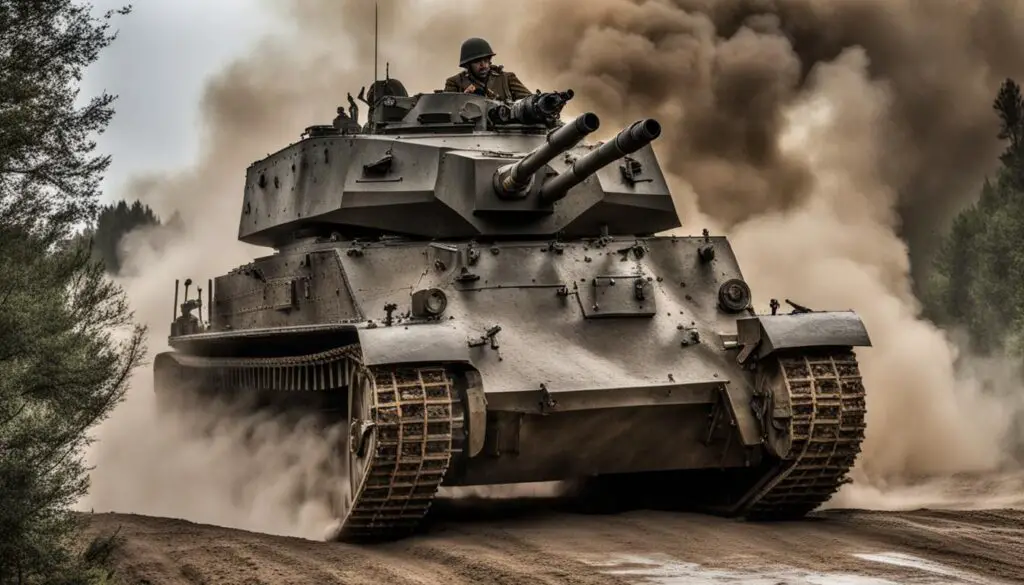
Mortars: Versatile Weapons for Trench Warfare
Mortars were essential weapons used in WW1 trench warfare due to their versatility, effectiveness, and mobility. The British Army relied on the Stokes mortar, a highly successful weapon that played a crucial role in supporting infantry operations.
The Stokes mortar had a firing rate of 20 bombs per minute and a range of 1,100 meters, making it a formidable weapon against enemy machine-gun and sniper posts. Its compact size allowed it to be easily transported and deployed in the challenging conditions of trench warfare. The mortar’s high rate of fire and steep trajectory allowed it to hit enemy positions from above, providing effective suppressive fire and contributing to successful offensives.
Mortars also played a vital role in mine detonation during WW1. Tunnelling operations were conducted to lay explosive mines beneath enemy positions, and mortars were used to trigger these mines, causing significant disruption to enemy lines. This tactic was particularly effective in offensive operations, where explosions cleared the way for infantry assaults and helped secure initial objectives.
The advantages of mortars in trench warfare were manifold. They could be quickly set up and relocated, allowing for rapid changes in firing positions. Their indirect fire capability enabled them to strike enemy positions without direct line of sight, providing a significant tactical advantage. Additionally, their high-explosive fragmentation bombs were effective against both personnel and structures, making them versatile weapons on the battlefield.
Table: Comparison of Key Mortars Used in WW1
| Mortar | Firing Rate | Range | Advantages |
|---|---|---|---|
| Stokes Mortar | 20 bombs per minute | 1,100 meters | Compact, high rate of fire, mobility |
| Mills Bomb | N/A | Hand-thrown | Portable, versatile |
| Medium Mortar | 5-10 bombs per minute | 500-600 meters | Balanced firepower and range |
In conclusion, mortars were crucial weapons in WW1 trench warfare, providing the British Army with a versatile means of engaging the enemy and supporting infantry operations. The Stokes mortar, in particular, proved to be highly effective with its rapid rate of fire and long range. Mortars not only played a significant role in suppressive fire against enemy positions but also served as a means of triggering explosive mines, contributing to successful offensives. Their adaptability, mobility, and firepower made them valuable assets on the battlefield.
Mines: Undermining Enemy Defenses
In World War 1, mines played a crucial role in undermining enemy defenses and disrupting their lines. Tunnels were dug under no-man’s land to lay explosive mines beneath enemy positions, causing widespread destruction during offensives. The detonation of mines was a strategic tactic employed by the British Army to break through enemy lines and gain control of key objectives.
One notable example of successful mine deployment was at Messines Ridge. In June 1917, the British detonated a series of massive mines that severely disrupted German defenses. The explosions created large craters and obliterated enemy positions, clearing the way for the British troops to advance. The use of mines at Messines Ridge demonstrated the devastating power of these underground weapons and their effectiveness in offensive operations.
The Effects of Mines on Offensives
The detonation of mines had significant effects on offensives during World War 1. The explosions caused widespread destruction of enemy infrastructure, such as trenches, bunkers, and fortifications, weakening their defensive capabilities. Mines also inflicted heavy casualties on enemy soldiers, with the explosions causing chaos and disarray among their ranks.
Mines not only physically disrupted enemy lines but also had a psychological impact. The fear of hidden mines created a sense of uncertainty and unease among enemy troops. This psychological warfare further contributed to the success of offensives, as it undermined the morale and confidence of the opposing forces.
Table: Mines Used in World War 1
| Mine Type | Explosive Power | Range | Deployment |
|---|---|---|---|
| Tunnel Mines | High | Varied | Dug under enemy positions |
| Trench Mines | Medium | Close range | Placed in enemy trenches |
| Anti-vehicle Mines | High | Varied | Placed on roads or strategic locations |
Rifles: The Most Commonly Used Weapon
In the trenches of World War 1, rifles were the standard weapon for infantrymen, providing soldiers with the means to engage targets at various distances. The Lee Enfield rifle, specifically the Short Magazine Lee Enfield (SMLE) rifle, was the primary rifle used by the British Army. Renowned for its accuracy and reliability, the SMLE rifle had a maximum range of 2,280 meters, making it a formidable weapon on the battlefield.
Rifles played a versatile role during WW1, not only as a long-range weapon but also as a bayonet platform. Soldiers often attached bayonets to their rifles, giving them a one-meter reach in hand-to-hand combat. This enabled infantrymen to defend themselves and engage in close-quarters combat when necessary.
In the confined spaces of the trenches, soldiers sometimes resorted to using improvised weapons like trench clubs. These clubs were typically made from everyday objects such as wooden staves, with nails or other sharp objects added for increased effectiveness. While not as technologically advanced as other weapons of WW1, improvised trench clubs demonstrated the resourcefulness and adaptability of soldiers in the face of adversity.
| Type of Rifle | Range | Accuracy |
|---|---|---|
| Lee Enfield SMLE | Up to 2,280 meters | High |
The rifles used in WW1 set the stage for modern warfare, showcasing the importance of accurate and reliable small arms. The versatility of rifles allowed soldiers to engage enemy targets both near and far, making them an essential tool for infantrymen in the challenging conditions of trench warfare.
Gas: The Silent Killer
Gas warfare was a devastating aspect of World War 1, with various lethal gases used by all sides. The introduction of poison gas fundamentally changed the nature of warfare, causing significant casualties and leaving a lasting impact on soldiers. Gas attacks created an invisible threat that could silently and indiscriminately kill or injure soldiers on the battlefield.
There were several types of gas used during WW1, including chlorine, phosgene, and mustard gas. Chlorine gas was the first to be deployed by the Germans in 1915, causing panic and confusion among the Allied forces. Phosgene, a more lethal gas, was later introduced and used with devastating effect. Mustard gas, known for its blistering and suffocating effects, caused severe injuries and long-term health problems for those exposed.
To protect themselves from gas attacks, soldiers were issued gas masks. These masks were designed to filter out the toxic gases and provide a breathable air supply. Gas masks became essential equipment for soldiers on the front lines, offering a life-saving defense against the silent killer. However, the masks were not foolproof, and soldiers still faced the constant fear and uncertainty of gas attacks.
| Type of Gas | Effects | Protection |
|---|---|---|
| Chlorine Gas | Caused respiratory distress, coughing, and vomiting | Early gas masks provided limited protection |
| Phosgene Gas | Attacked the respiratory system, causing severe lung damage and death | Improved gas masks were developed to provide better protection |
| Mustard Gas | Caused blistering of the skin, blindness, and severe internal injuries | Gas masks with special filters were developed to protect against mustard gas |
“The use of gas in warfare was a terrifying and brutal tactic. Soldiers lived in constant fear of a gas attack, knowing that the effects could be devastating. Gas masks provided some protection, but the psychological impact of gas warfare was profound. It was a silent killer that left its mark on the soldiers who experienced its horror.” – Veteran of World War 1
Improvised Weapons: Innovations in Combat
In the chaos of trench warfare, soldiers in World War 1 often had to rely on their resourcefulness to find creative solutions for combat. These improvised weapons, born out of necessity, played a significant role in trench raids and surprise attacks. Let’s explore some of the weapons used during these daring missions.
Weapons Used in Trench Raids
Trench raids were often conducted to gather intelligence, capture prisoners, or disrupt enemy lines. In these close-quarter encounters, soldiers had to rely on weapons that were compact, effective, and easy to handle. One such weapon was the morning star, an improvised weapon made from polo balls and nails or spikes. Its spiked design allowed soldiers to deliver deadly blows in hand-to-hand combat, enhancing their chances of success in these dangerous missions.
Another commonly used improvised weapon was the bullet spike. Soldiers would attach a sharpened bullet to a wooden handle, creating a makeshift dagger. This weapon was effective in close-quarters combat, allowing soldiers to slash and stab at enemy combatants during raiding operations. The element of surprise coupled with these unconventional weapons gave soldiers an edge when engaging the enemy.
Creative Solutions in Combat
The use of improvised weapons extended beyond trench raids. Soldiers were known to repurpose everyday items to aid them in battle. For example, entrenching tools, originally used for digging trenches, were often used as makeshift clubs to fend off enemy soldiers. Soldiers also utilized bayonets, attached to their rifles, not only for stabbing but also as a close-quarter weapon in hand-to-hand combat.
During the intense and unpredictable nature of World War 1, the ability to adapt and innovate was crucial for survival. Soldiers used their ingenuity to repurpose common objects into deadly weapons, showcasing their resourcefulness and determination to overcome the challenges of trench warfare.
| Weapon | Description | Advantages |
|---|---|---|
| Morning Star | Improvised weapon made from polo balls and nails or spikes. | – Compact and easy to handle – Deadly in close-quarters combat |
| Bullet Spike | Sharpened bullet attached to a wooden handle. | – Portable and versatile – Effective in hand-to-hand combat |
| Entrenching Tool | Originally used for digging trenches, repurposed as a makeshift club. | – Readily available – Effective as a close-quarter weapon |
| Bayonet | Attached to rifles, used for stabbing and close-quarter combat. | – Dual purpose weapon – Extended reach in hand-to-hand combat |
New Developments in Technology and Tactics
The First World War was a period of immense technological advancements and the development of new tactics that forever changed the face of warfare. The use of mechanized vehicles, such as armored cars and tanks, revolutionized mobility on the battlefield and provided a strategic advantage to the armies that employed them. These vehicles allowed for greater speed and maneuverability, enabling troops to break through enemy lines and quickly gain ground. The introduction of tanks in particular proved to be a game-changer, as they could traverse difficult terrain and provide both protection and firepower to soldiers.
In addition to mechanized vehicles, aircraft played a crucial role in WW1 and marked the rise of aerial warfare. Initially used for artillery spotting and reconnaissance, planes later became equipped with machine guns and were used in aerial combat. Bombs were also dropped from airplanes, targeting enemy positions and disrupting their defenses. The development of aircraft technology during this time laid the foundation for future advancements in aviation and aerial warfare.
The introduction of new weapons and tactics, such as machine guns, gas, and trench warfare, also had a significant impact on the course of the war. Machine guns, with their high rate of fire and deadly accuracy, provided devastating firepower and were instrumental in defending and attacking positions. Gas warfare, despite its horrifying consequences, became a common tactic used by all sides, leading to the development of gas masks and other protective equipment. Trench warfare, marked by its complex network of trenches and fortified positions, required soldiers to adapt their tactics and employ new strategies to gain an edge on the battlefield.
The Technological Impact on Modern Warfare
The technological advancements and innovations of WW1 laid the groundwork for modern warfare. The introduction of mechanized vehicles and aircraft paved the way for the development of faster and more powerful machines in future conflicts. Tanks, in particular, have become an integral part of modern armies, providing essential firepower and protection in various combat scenarios. The lessons learned from gas warfare also influenced the development of chemical weapons and protective measures in subsequent conflicts.
The tactics and strategies employed during WW1, including trench warfare and the use of machine guns, still have an impact on modern warfare. Military leaders studied the successes and failures of this era to inform their own strategies and develop new tactics for future conflicts. The innovations and advancements of WW1 shaped the face of warfare, highlighting the importance of technology and its ever-evolving role in military operations.
Conclusion
In conclusion, the weapons used in WW1 had a profound impact on the nature of warfare and continue to leave a lasting legacy in modern warfare. From the devastating power of artillery and the deadly efficiency of machine guns to the game-changing introduction of tanks and the rise of aerial warfare, these weapons revolutionized the battlefield.
The advancements in military technology during WW1 provided unprecedented firepower, mobility, and strategic advantages. However, they also resulted in immense casualties and destruction. The introduction of new weapons and tactics, such as gas warfare and trench warfare, shaped future conflicts and set the stage for modern warfare as we know it today.
The legacy of WW1 weapons can still be seen in modern warfare. The developments in artillery, machine guns, tanks, aircraft, and other weapons paved the way for future innovations and influenced the strategies and tactics used in conflicts around the world. The impact of these weapons on the course of history cannot be overstated.
As we reflect on the weapons used in WW1, we are reminded of the sacrifices made by the brave soldiers who fought in this grueling conflict. Their experiences and the technological advancements of the time continue to shape the way wars are fought, underscoring the importance of understanding the history and impact of these weapons in the world today.
FAQ
What weapons were used in WW1?
The British Army used a variety of weapons during WW1, including artillery, machine guns, aircraft, mortars, mines, rifles, gas, and improvised weapons.
What role did artillery play in WW1?
Artillery was the most destructive weapon during WW1 and played a crucial role in destroying enemy positions, troop concentrations, and wire. It was initially used for bombardment before infantry advances, but later used defensively and in support of troop advancements.
How were machine guns used in WW1?
Machine guns were one of the deadliest weapons used in WW1. The British Army relied on the Vickers and Lewis machine guns, which provided devastating firepower in trench warfare and forced soldiers to seek cover.
What was the role of aircraft in WW1?
Aircraft in WW1 were initially used for artillery spotting and reconnaissance, but later equipped with machine guns and used for aerial combat. Bombs were also dropped from airplanes, targeting enemy positions and facilities.
How did tanks change the battlefield in WW1?
Tanks were introduced in WW1 and provided protection and mobility to troops. They allowed for breaking through enemy lines and revolutionized battlefield mobility.
What was the importance of mortars in trench warfare?
Mortars were crucial in trench warfare due to their size, mobility, and effectiveness against enemy machine-gun and sniper posts. The British Stokes mortar was the most successful mortar used in WW1.
How were mines used during WW1?
Mines were deployed using tunnelling operations, with explosions causing significant disruption to enemy lines. They played a crucial role in offensives and gaining initial objectives.
What types of rifles were used in WW1?
The British Army relied on the Short Magazine Lee Enfield (SMLE) rifle, known for its accuracy and range. Bayonets and improvised trench clubs were also used for close-quarters combat.
What was the impact of gas warfare in WW1?
Gas attacks caused horrific casualties and led to the development of gas masks and protective equipment. Soldiers had to be prepared for gas attacks, using warning signals like rattles, horns, and whistles.
What were some improvised weapons used in WW1?
Soldiers in WW1 used improvised weapons like morning stars made from polo balls and bullet spikes for trench raids and surprise attacks.
How did WW1 weapons impact modern warfare?
The development and use of weapons in WW1, including artillery, machine guns, tanks, and aircraft, forever changed the face of warfare and set the stage for future innovations in military technology.
Source Links
- https://www.nam.ac.uk/explore/weapons-western-front
- https://www.historyonthenet.com/world-war-one-weapons
- https://doughboy.org/how-did-world-war-i-change-weapons-for-today/
